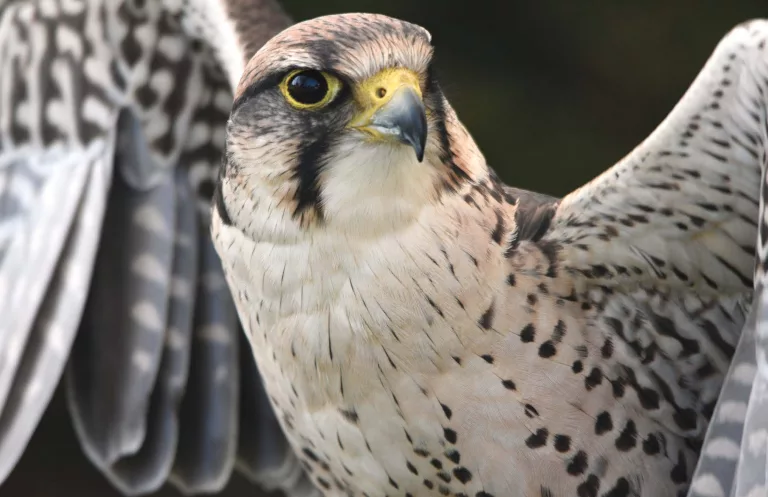
By Jim Knox
I flash of motion caught my eye. The swift beating of sharply pointed wings zipped the creature past me like a dart. There, somewhere just south of the Merritt Parkway, it vanished into a sheltering grove of hardwoods. In that brief moment, I had just observed an uncommon Connecticut resident whose unpredictable occurrences make it a memorable wildlife sighting throughout its vast range.
The Merlin, Falco columbarius, is a powerful little falcon that employs surprise and speed to ambush its fleet avian prey. In fact, its scientific name, columbarius means pigeon, referring to both its robust pigeon-like build and its fondness for fast flying pigeon and dove prey. Tucking their wings close to their bodies in swept position, and zig zagging close to the ground like swallows, Merlins fluidly “bank and flank” in pursuit of prey. Possessing agility on the wing that enables it to catch songbirds and shorebirds—and even darting dragonflies and flitting bats that elude other hunters—a hunting Merlin is a remarkable sight. Ranging from 10 to 14 inches long with a 20-29-inch-long wingspan, these falcons are small, yet their compact frames tip the scales at 6 to 11 ounces, imbuing them with muscle power to overtake and capture their swift prey. Though typically Slate blue, males can range from silver to black on the cap, wings, and back with a cream buff-streaked breast. Females and juvenile birds are brownish gray above with similar cream and buff streaking below.
With a global range encompassing open habitat, shrubland, forests, meadows, marshes, rural and urban parks, prairies and steppe throughout the Americas, Europe, Asia, and Africa, the Merlin is a highly adaptable and successful creature. With populations stable and increasing throughout the world, Merlins have many factors contributing to their success. They are consummate opportunists, forgoing nest building, utilizing the nest of other species such as crows and magpies, conferring an advantage in prime nest locations and energy-saving preparation. These falcons can thrive in wilderness or in close proximity to people, hunting ubiquitous, introduced House Sparrows in cities and towns. They are also expert pair-hunters which coordinate to more effectively flush and capture flocking birds such as starlings and waxwings. One bird will fly low and fast, diving into a flock, chasing the birds into their mate’s line of attack or drive the flock high in the sky to exhaust them out where their mate will single out their spent prey to make the kill.
In our region, Merlins typically breed and nest in northern New York, Vermont, New Hampshire, and Maine. They pass through The Nutmeg State on their way to their migration destinations further south yet some overwinter in Connecticut, mainly along our coast. Though they tend to appear unpredictably, a flock of birds—especially shorebirds—exploding into flight is often a strong indicator that a Merlin is on the hunt. If you are lucky enough to witness this, scan quickly as these falcons can rocket by at more than 50 miles per hour!
Beautiful, powerful, and swift, the Merlin inspires admiration, but it also evokes emulation. A bird of nobility down through the centuries, the Merlin was an esteemed hunting falcon to royals the world over. Mary Queen of Scots and Catherine the Great hunted Skylarks with Merlins, earning the bird the title Lady’s Hawk. The reasons for the Lady’s Hawk’s success are pronounced. These gifted hunters exhibit hallmark patience, observing their surroundings—scanning for opportunity from prominent perches. Resting, when necessary, they conserve their energy to tackle equally agile prey as well as far larger prey such as ptarmigans or grouse.
So how can a falcon slightly larger than a Robin aid us in our daily lives? Simply, we can adopt lessons from these little powerhouses. Combining offensive strategy with innate ability, the Merlin is hard to beat. When identifying objectives, we should take ample time to observe and assess our options, selecting a target before locking onto it with single-minded pursuit. Once a goal is achieved, we can take a vantage point that enables us to assess our next major goal, rest up for the relentless pursuit of that goal, and then launch our explosive effort to achieve victory.
With hunting success rates hovering between 4.9-17.2%, even the swiftest Merlins miss more than succeed—their frequent failures stoking their redoubled effort—driving their inevitable success. When we possess the good fortune of a skilled partner, we should avail ourselves to teamwork which confers energy conservation and synergy alike. With the Merlin as our guide, our personal victories will not be assured by our swiftness or strength alone, but by our ability to gather ourselves after falling short, to spread our wings, and to launch anew.
Jim Knox serves as the Curator of Education for Connecticut’s Beardsley Zoo where he directs education and conservation initiatives. A Member of The Explorers Club, Jim enjoys sharing his passion for wildlife conservation with audiences in Connecticut and beyond.




